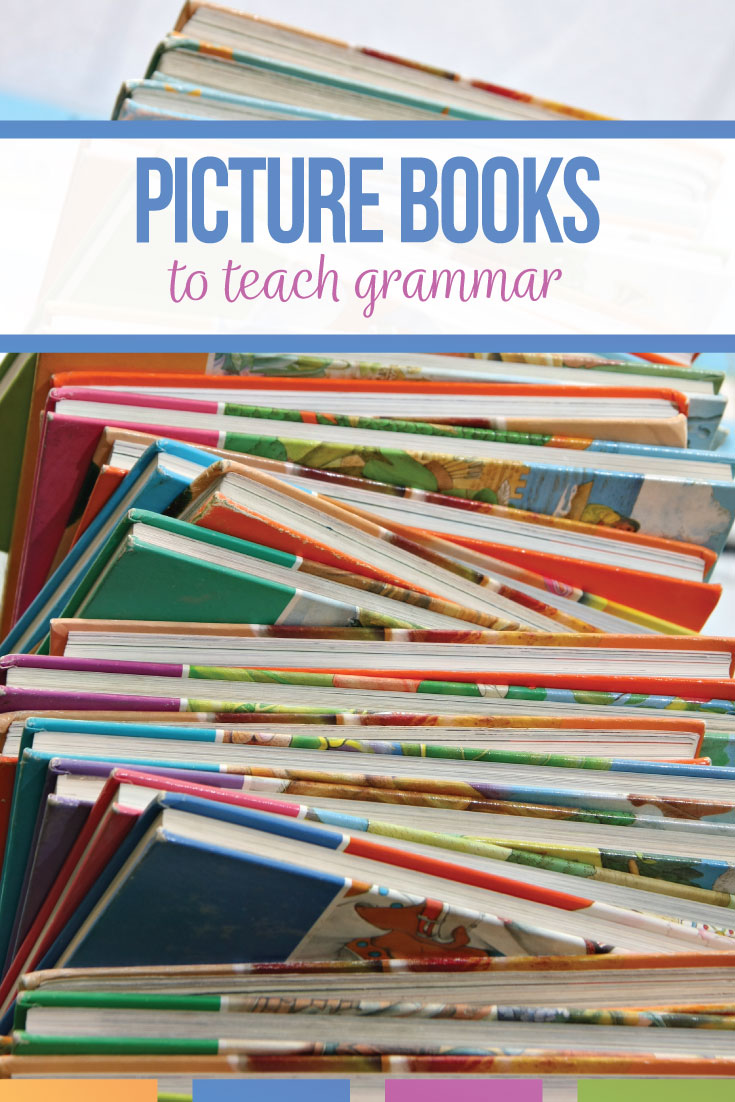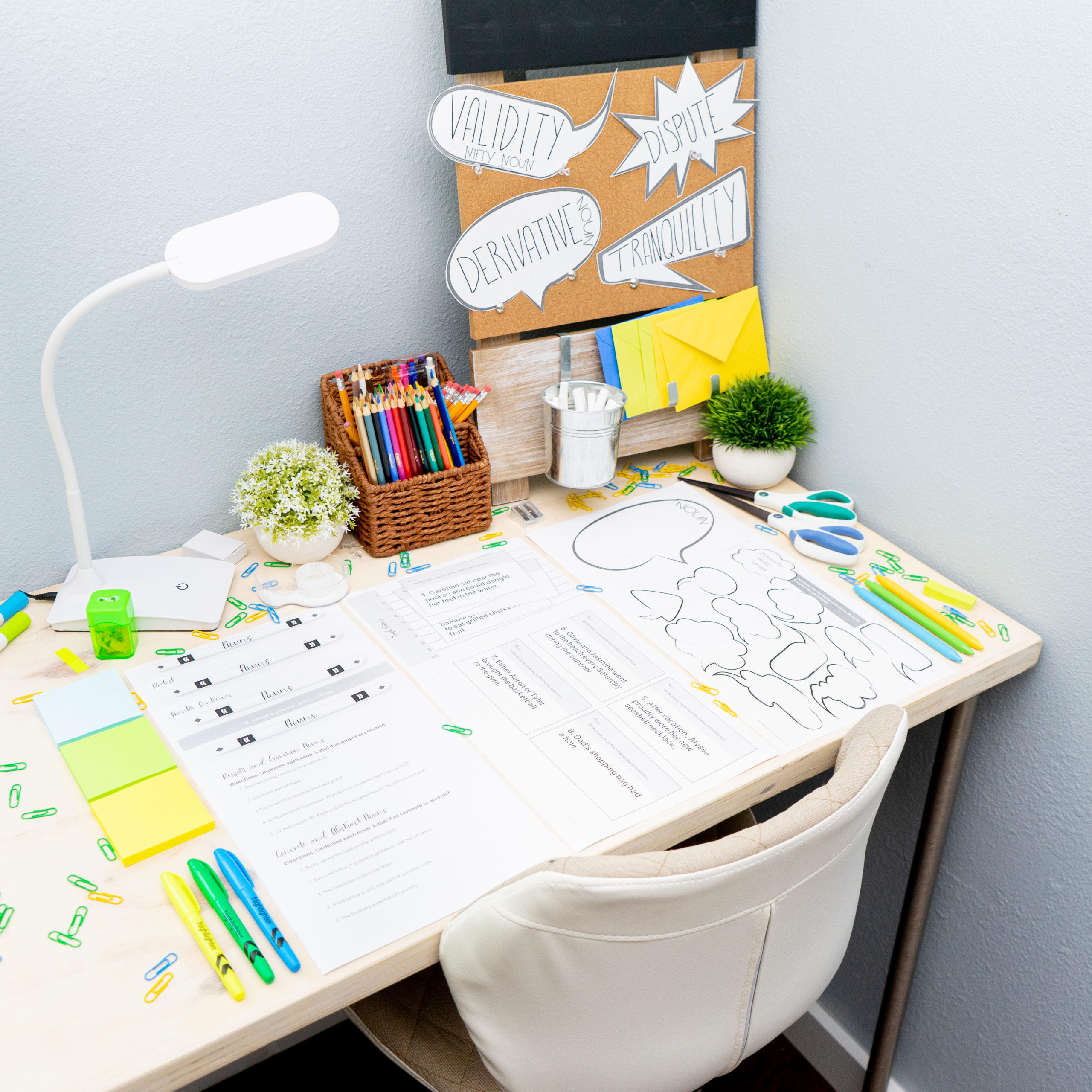Do you use children’s books to teach grammar? Bring them into your secondary classroom and use these bright and colorful books to teach grammar concepts.
In my classroom library, I keep baskets of children’s books. (I sometimes call them “everybody books.”) My students read them, and I often use those books to emphasize literary devices.
Another idea is to use children’s books to teach grammar. These books typically have hard covers, bright pictures, and non-threatening sentences. Plus, children’s books are often inexpensive (compared to YA books), and you might have enough books for all students to have one.
Why use children’s books to teach grammar?
The fun and directness of picture books encourage students to have fun and relax. With simpler sentences, older students can find success with a grammatical approach. Here are four quick ways to use children’s books to teach grammar.

Use alphabet books for the eight parts of speech.
I love most alphabet books, but my favorite set is the Alpha Tales series from Scholastic. These books are stories – more than pictures. Each letter has its own book with pictures and a story centered around that letter. The final page prompts readers to find pictures of “things” that begin with the assigned letter. Plugging “nouns” in for the word “things” is easy to do. Here is part of the from the “E” book:
The only adjectives are “excellent” and “exciting.” The rest are nouns! For advancement, what verbs start with “E”? Earn, empty, exercise.
These books are a family favorite for learning sounds and the final page really lends itself to teaching nouns. They also work well as kids work on other parts of speech. For instance, the book “Z” is about Zach, the lazy zebra. It has “Z”:
- nouns – Zach, zoo, zucchini, and ziti.
- verbs – zap, zoom, and zigzag.
- adjectives – zany and zillion.
Go grammar hunting.
I’ve outlined specifics of going on a grammar hunt before, but basically, students choose a grammar concept to “hunt” and find examples. Picture books are perfect for hunting different concepts. For instance, a student might want to hunt for pronouns and antecedents. Another might find gerunds. I often let students choose what concept to hunt.
For a hunt, I ask students to choose their concept, and then I hand each student a book. You can keep track of the grammar concept with these task cards. More times than not, students know what their friends are seeking, and they find examples in their books. Review for everyone!
Organize stations.
When I organize stations for older students, I put different activities at different stations. Often, I have practice sentences. Another option is to include a station or two with a children’s book. Ask students to find a complex idea (like types of sentences) using a simple book.
The beauty of grammar stations is that each station can be a different piece of work. So while grammar worksheets shouldn’t be the only grammar activity, a station can be a worksheet, another a video, and another a picture book.
Pull mentor sentences.
I know that might sound silly, but I use children’s books to teach grammar ideas such as abstract nouns, interrogative pronouns, and verbals. Why? Well, I simply have discovered the best examples in children’s books. Long lists and funny expressions fill books for younger readers.
These quirky sentences often contain difficult to find examples of grammar concepts. Plus, secondary students enjoy the switch from higher leveled reading. My favorite series for mentor sentences is Mercy Watson.
Utilize one-Pagers.
My students love picture books so much that I created one-pagers for students to find verbs, adjectives, and adverbs. I’ve found that many advanced standards ask students to identify how words contribute to the tone or how words move the plot forward. If students struggle with these concepts, complete a one-pager and ask students to discover how they words move the story forward (or whatever the standard asks). Then, connect that success to a more difficult piece of work.
With the one-pagers, you can also provide a break in the middle of a writing unit. Give students a picture book and ask them to find verbs, adjectives, and adverbs. Sometimes looking at a mentor text (even a picture book) can inspire students to modify the language in their writing. Encourage students to use their completed one-pager as a note sheet for their writing.
Experiment with punctuation, book lists, conjunctions, and more.
I use children’s books to teach grammar! Students enjoy the change in pace, maybe because the books are less intimidating? They are familiar with the stories? They think I’m playing a fun game? (I’m not totally sure!)
Picture books are more than tools for elementary school. No matter where your students need review, look for examples to add to your grammar instruction. Clear examples of apostrophes, commas, and semicolons as well as prepositions, collective nouns, and pronouns.
Give it a try: find some children’s books and implement one of the above methods into your grammar lessons. I’d love to add to my list of books—add some in the comments below.


